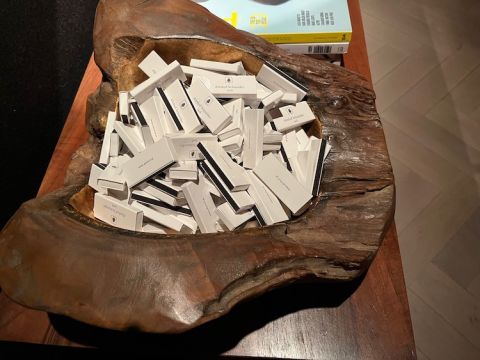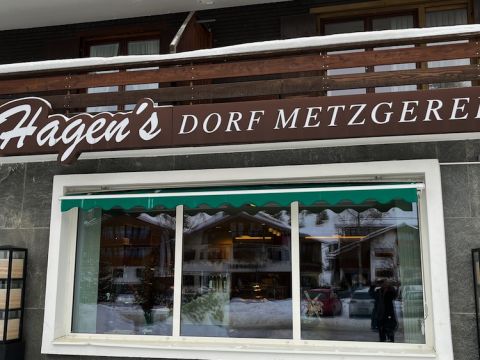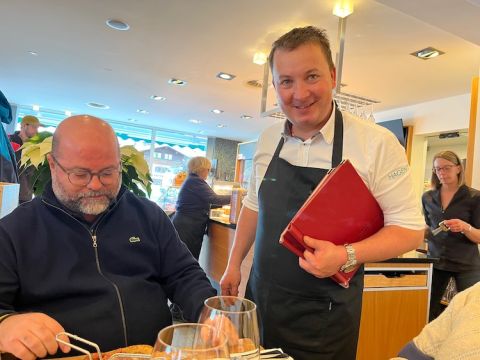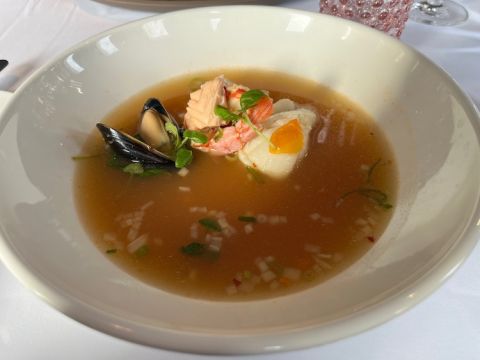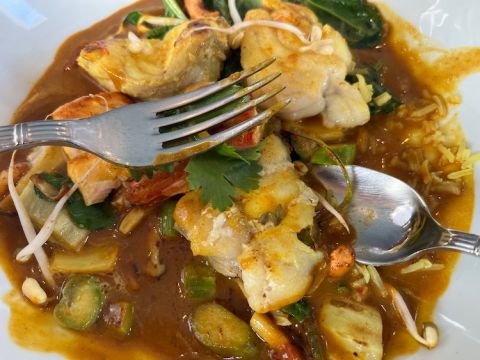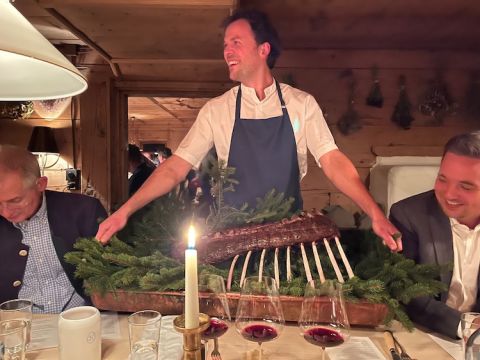Any visit to Austria, particularly in winter, reminds me how unchanged this country appears to be in so many respects. The snow, seemingly everywhere, seems to sparkle. Mountains loom large in every direction. The young man who met us in a taxi at Zurich airport looked as if he’d come straight out of The Sound of Music. Many of the waitresses still wear traditional dirndls as their distinctive uniform.
Although standards of genuine hospitality in hotels and restaurants are as high as they have always been (a Scandinavian explained to me that this is due in part to the fact that the country is so close geographically to Italy), certain things do come as a shock. The ubiquity of ashtrays is one. The fact that by the reception in every restaurant I was in there is invariably a bowl filled with boxes of matches. Also, on certain menus there are dishes described as ‘ladies’ cut (180 grams of meat)’ and ‘men’s (250 grams)’. Political correctness does not seem to figure at all.
On the plus side, certain traditions continue and make eating out in Austria as satisfying as it has always been. Not that long after my article bemoaning the absence of soups on far too many British menus, here they proliferate. Most restaurants have at least two, some as many as three, helped no doubt by the cold outdoors.
And Austria, perhaps only today equalled by Italy, keeps alive the restaurant tradition whereby husband and wife work alongside each other, a custom that used to be so common in France but seems no longer to be the case there, sadly.
In the glamorous ski resort of Lech for three days right before Christmas, I managed to eat and drink extremely well at four very different restaurants, in each of which a husband-and-wife team worked together. I even stayed at a notably smart hotel that was owned and led by a very hard-working husband and wife (and where we most surprisingly drank a wonderful bottle of a previously unknown, to us, California Pinot Noir).
The first, and by far the most accessible, of these four establishments was Hagen’s on the main road through the town. This was initially a family butcher’s shop owned and operated by Kuno and Doris Hagen. Then 15 years ago their son Florian returned from working in London, specifically at the range of restaurants and food shops created by Conran Restaurants at Tower Bridge. It was obvious to him that, with the hotels buying their meat from wholesalers rather than butchers, what had been the Hagens’ very large cold store had become surplus to requirements. Just the space for a restaurant, he thought.
Since then it has prospered. The front part still trades as a shop, selling everything from cucumbers to fillets of beef, but at noon until 7 pm they offer traditional Austrian warmth and particularly solid Austrian food. I enjoyed a beef consommé with a massive liver dumpling followed by a dish on the ‘specials’ blackboard described as calves’ liver with rice. I was a little concerned that the waitress did not ask me how I would like it cooked but any fears were groundless: what arrived was a bowl full of the liver that had been sliced into extremely thin pieces before being sautéed. It was excellent. We drank a bottle of mature Austrian Riesling chosen by the Trinkreif team, the Vienna wine retailer involved in organising a week of wine events in Lech, and left extremely happy and much warmer than when we had walked in.
From here the gondola lift up to Oberlech is a short walk across the road. Oberlech, entirely free of cars, is an outpost of skiers’ heaven but it is also very much worth the €7 cost of the ticket for anyone who is just plain hungry, as I was the following lunchtime.
My goal on this occasion was a five-minute walk from the top of the gondola to lunch at Sporthotel Murmeli, to enjoy the cooking of Wolfgang Strauss. What I discovered was a gem.
Strauss is a man in his 50s who, together with his wife, Anne-Marie, has created a delightful hotel and restaurant: calm, extremely welcoming, warm, and a place where everything appears to be quietly under control. The dining room, onto which sunshine poured, looked most inviting.
The Strauss menu is unexpectedly distinguished by the presence of one ingredient: fish. Lech itself is high up in the Austrian Arlberg alps, so meat is by far the most common ingredient on every menu. But here fish features not just on the main course but as a starter too, in the form of a ‘bouillabaisse’, described on the menu as a clear fish soup with garlic pearls, and a main-course fish curry from monkfish, cod, salmon and wild prawns. I immediately ordered both.
The bouillabaisse was particularly good – even in the absence of my beloved rouille – while the fish curry had plenty of fresh fish and cashew nuts swimming in a lively sauce that could pass muster with any curry practitioner. With this I enjoyed a glass of house Grüner Veltliner (€6.50) and paid a bill of €85 including service.
I skipped dessert, having made up my mind to walk back down to Lech. The waitress kindly told me to stick to the route marked out by sticks in pink, which I did. Walking the steep, snowy path through the trees, I fell only once.
My last two excellent meals in Lech, and our three-night stay there, were thanks to husband and wife Gerold and Katia Schneider, who run the magnificent Hotel Almhof Schneider, which is five-star, expensive (over €1,000 a night for a speculative booking I researched for early April 2023) and seemingly fully booked throughout the winter and spring seasons by returning families.
Their table d’hôte restaurant is every bit as good as their à la carte one and it was here that we made the discovery of that California Pinot, made by the late Jim Clendenen of Au Bon Climat but with a label we had not encountered before. Their extremely well-edited wine list opens with a page of suggestions from Joseph the sommelier. The final recommendation is a bottle listed as Barham Mendelsohn Pinot Noir 2013, surprisingly well priced for such a mature rarity. A quick exchange of emails with San Francisco-based Purple Pager and barrel broker Mel Knox, who had been a great friend of Wild Boy, confirmed that ‘Jim made wine with this neighboor of ours … ok, he is about ten blocks and $5 million away from us … Richard Mendelsohn has a beautiful vineyard near Windsor.’ We drank this gem with great pleasure and toasted Clendenen’s memory.
The Schneiders also played a significant role in my final, and perhaps most memorable, meal. It took place in a simple converted farmhouse, the Klösterle in nearby Zug, which we reached quite easily via the 702 bus. The hard work on this occasion was carried out by yet another husband-and-wife team, Jakob Zeller (originally from the South Tyrol) and Singapore-born Ethel Hoon. They had met while working in Fäviken restaurant in the far north of Sweden and where I had the pleasure of eating in 2011.
In 2019 Zeller and Hoon were persuaded by Katia Schneider, impressed by a visit to Fäviken, to take over this 400-year-old building that back in the 1980s had been converted into a working restaurant. (Interestingly, both here and the previous incarnation at Fäviken had been fondue restaurants!) Zeller and Hoon are now successfully installed in this atmospheric farmhouse in which several of the doorways are considerably less than convenient for the tall Zeller.
The main difference between here and the now-closed Fäviken is that everything here is served as ‘shared plates’ (‘family style’ in American, centre-table in Hoon’s words), an approach that allows this talented couple to serve food that combines being both stimulating and comforting at the same time – such as an unmissable cavolo nero and buckwheat gratin; a grilled, massive piece of red deer with salted chanterelles (pictured above); and a pavlova made of colostrum milk, the first form of milk produced from the mammary glands of mammals.
As Hoon explained by email later (she was too busy during our dinner for a large group of wine professionals), ‘Obviously, having both worked at Fäviken for about three years, our philosophy and cooking styles are influenced in some ways by our time there. In particular, a big takeaway was how to source the best produce. Magnus Nilsson (Fäviken’s founder) used to always say you can’t take something mediocre and make it good – it always starts with a good ingredient. Another takeaway was how to use some of these more “traditional” preservation techniques in a restaurant setting, and also the very classic way of cooking (we cook meats mainly over the grill or in the pan and oven, no sous vide etc). And in a way, because of the altitude that the restaurant stands at (1,800 m/5,900 ft above sea level), the climate and vegetation are very similar to northern Sweden. We find similar wildflowers, berries and mushrooms in the summer and fall as we would in and around the grounds of Fäviken. What Jakob and I enjoy most about the work at Klösterle is the connection we have with the place we are in and the direct relationship we have with our producers.’
Thanks to these four highly talented husbands and wives, the Lech I enjoyed is not just for skiers…
Hagen’s Lech 134, Austria; tel: +43 (0) 5583 2303
Murmeli Oberlech 287, 6764 Lech, Austria; tel: +43 (0) 5583 2467
Hotel Almhof Schneider Tannberg 59, 6764 Lech, Austria; tel: +43 (0) 5583 3500
Klösterle Zug 27, 6764 Lech, Austria; tel: +43 (0) 5583 3190; menu €110 per person
Explore Austria on JancisRobinson.com in over 100 articles.


